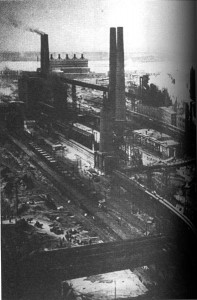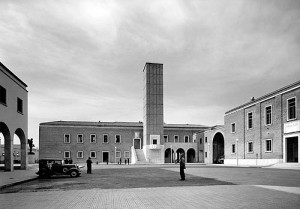The city of Magnitogorsk was founded as a center of industrialization, however even as it failed on many fronts it was a progressive center of industrialization. In the 1930’s the Soviet Union was in need of industry, and so the plan to create industrial cities was implemented. Detailed in the article Peopling Magnitostroi: The Politics of Demography by Stephen Kkotkin is the reasoning, creation and outcome of Magnitogorsk as both an industrial city and as a “factory for remaking people”. ((Kotkin, Peopling Magnitostroi 63))
In an attempt to industrialize the country, industrial cities were created throughout the Soviet Union. By recruiting citizens, military personnel assignment, foreign workers (European refugees, hired technical personnel and tourists) and the incidental acquisition of wandering peasants (samotek ) Magnitogorsk’s population rapidly grew. ((Kotkin, Peopling Magnitostroi 70)) However, the city became a ‘revolving door’ of workers due to the poor living conditions and low wages. Some of the original workers were otkhodnik- peasant seasonal workers, who saw factory employment as a supplement to their agricultural income. ((Kotkin, Peopling Magnitostroi 71)) In order to maintain steadier population the Soviet Union saw it necessary to eliminate the seasonal workers by “transform[ing] the construction industry into a year-round activity”. ((Kotkin, Peopling Magnitostroi 72))
In 1933 The Soviet Union became afraid of the “peasnatization” of the workforce. As the ideal underclass was the proletariat efforts to educate the largely literate and unskilled work force began. ((Kotkin, Peopling Magnitostroi 75)) This organized system of education proved to be less effective than on the job training, during which individuals were instilled with the belief that with even the smallest extra effort they could become a hero to the Soviet Union. These sentiments gave rise to workplace competition and national pride.
With the issue of desertion sill prominent within the city, a passport system was created. The passports, which could have prevented the misuse of trains and government money, became an opportunity for the rise of black markets because of the demand for documentation. Even after many of the pitfalls of Magnitogorsk, it is still viewed as a successful industrial center that taught its citizens national pride and created a trained working class.
What struck me as I read the article was the need for progress, even when nothing was in fact achieved. The construction of the damn is the greatest instance of a failed but somehow respected occurrence. While it is true that the damn was built ahead of schedule and as a result party authority vastly increased, the damn was not functional and almost as soon as construction was completed it once again began. ((Kotkin, Peopling Magnitostroi 80)) Thant the Soviet Union was able to turn a major construction failure into a morale booster and convince the workers that even “the lowest individual could become a great hero by straining to pour an extra load of cement” is a testament to the strength of the collective mindset ((Kotkin, Peopling Magnitostroi 80)) The ability of the Bolsheviks to deftly turn a critique of their shortcomings into a party asset is one of the many characteristics that helped to keep the party in power during the Soviet Union.


